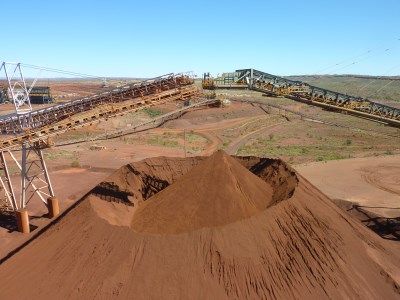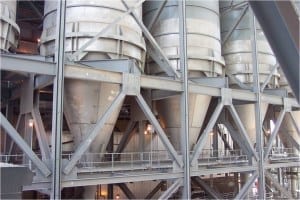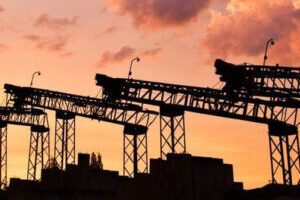Services List
-
Services By Handling Problems

Stockpile Design
Gravity reclaim stockpiles are used for the short-term storage of bulk materials during material handling processes.
The design of associated storage and handling facilities requires knowledge of the bulk solid material characteristics over a range of different operating conditions.
TUNRA Bulk Solids (TBS) flow properties test work is required to be able to calculate the optimum stockpile and rathole geometry in order to maintain the required live capacity. Favourable concept design of the hopper and feeder interface is also important to ensure the best performance under all operating conditions.
Material Characterisation for Design
The comprehensive laboratories at TBS permit the characterisation of bulk material properties using standard test procedures to determine unconfined yield strength and internal friction angles as functions of major consolidation stress for bulk materials. The type and range of tests required depend on the moisture content and type of storage facility to be designed.
On the other end of the spectrum, when uncovered stockpile storage facilities are located in close proximity to populated areas, dust control may be of vital importance. A detailed description of the range of services related to the characterisation of materials can be accessed in the Flow Properties Testing and/or Dust (Environmental) Testing.
Design Services for Stockpiles
In addition to the bulk materials characterisation services, our highly qualified and committed team of specialist engineers and consultants at TBS offer assistance with the design of stockpiles including:
- Design audits and reviews of new and existing gravity reclaim stockpiles
- Draw-down loads on trestle legs and buried columns
- Stockpile draw-down and live capacity modelling and calculations
- Conceptual design for
- Optimum feeder interface geometry
- Effective hopper geometry
- Optimisation of number of hoppers, geometry and location to obtain required / maximum live capacity
Case Study
The following case study is an example of a project completed by TBS to increase the live capacity of an iron ore stockpile:
-
Services By Industry

Stockpile Design
Gravity reclaim stockpiles are used for the short-term storage of bulk materials during material handling processes.
The design of associated storage and handling facilities requires knowledge of the bulk solid material characteristics over a range of different operating conditions.
TUNRA Bulk Solids (TBS) flow properties test work is required to be able to calculate the optimum stockpile and rathole geometry in order to maintain the required live capacity. Favourable concept design of the hopper and feeder interface is also important to ensure the best performance under all operating conditions.
Material Characterisation for Design
The comprehensive laboratories at TBS permit the characterisation of bulk material properties using standard test procedures to determine unconfined yield strength and internal friction angles as functions of major consolidation stress for bulk materials. The type and range of tests required depend on the moisture content and type of storage facility to be designed.
On the other end of the spectrum, when uncovered stockpile storage facilities are located in close proximity to populated areas, dust control may be of vital importance. A detailed description of the range of services related to the characterisation of materials can be accessed in the Flow Properties Testing and/or Dust (Environmental) Testing.
Design Services for Stockpiles
In addition to the bulk materials characterisation services, our highly qualified and committed team of specialist engineers and consultants at TBS offer assistance with the design of stockpiles including:
- Design audits and reviews of new and existing gravity reclaim stockpiles
- Draw-down loads on trestle legs and buried columns
- Stockpile draw-down and live capacity modelling and calculations
- Conceptual design for
- Optimum feeder interface geometry
- Effective hopper geometry
- Optimisation of number of hoppers, geometry and location to obtain required / maximum live capacity
Case Study
The following case study is an example of a project completed by TBS to increase the live capacity of an iron ore stockpile:
-
Services By Material Type

Stockpile Design
Gravity reclaim stockpiles are used for the short-term storage of bulk materials during material handling processes.
The design of associated storage and handling facilities requires knowledge of the bulk solid material characteristics over a range of different operating conditions.
TUNRA Bulk Solids (TBS) flow properties test work is required to be able to calculate the optimum stockpile and rathole geometry in order to maintain the required live capacity. Favourable concept design of the hopper and feeder interface is also important to ensure the best performance under all operating conditions.
Material Characterisation for Design
The comprehensive laboratories at TBS permit the characterisation of bulk material properties using standard test procedures to determine unconfined yield strength and internal friction angles as functions of major consolidation stress for bulk materials. The type and range of tests required depend on the moisture content and type of storage facility to be designed.
On the other end of the spectrum, when uncovered stockpile storage facilities are located in close proximity to populated areas, dust control may be of vital importance. A detailed description of the range of services related to the characterisation of materials can be accessed in the Flow Properties Testing and/or Dust (Environmental) Testing.
Design Services for Stockpiles
In addition to the bulk materials characterisation services, our highly qualified and committed team of specialist engineers and consultants at TBS offer assistance with the design of stockpiles including:
- Design audits and reviews of new and existing gravity reclaim stockpiles
- Draw-down loads on trestle legs and buried columns
- Stockpile draw-down and live capacity modelling and calculations
- Conceptual design for
- Optimum feeder interface geometry
- Effective hopper geometry
- Optimisation of number of hoppers, geometry and location to obtain required / maximum live capacity
Case Study
The following case study is an example of a project completed by TBS to increase the live capacity of an iron ore stockpile:












